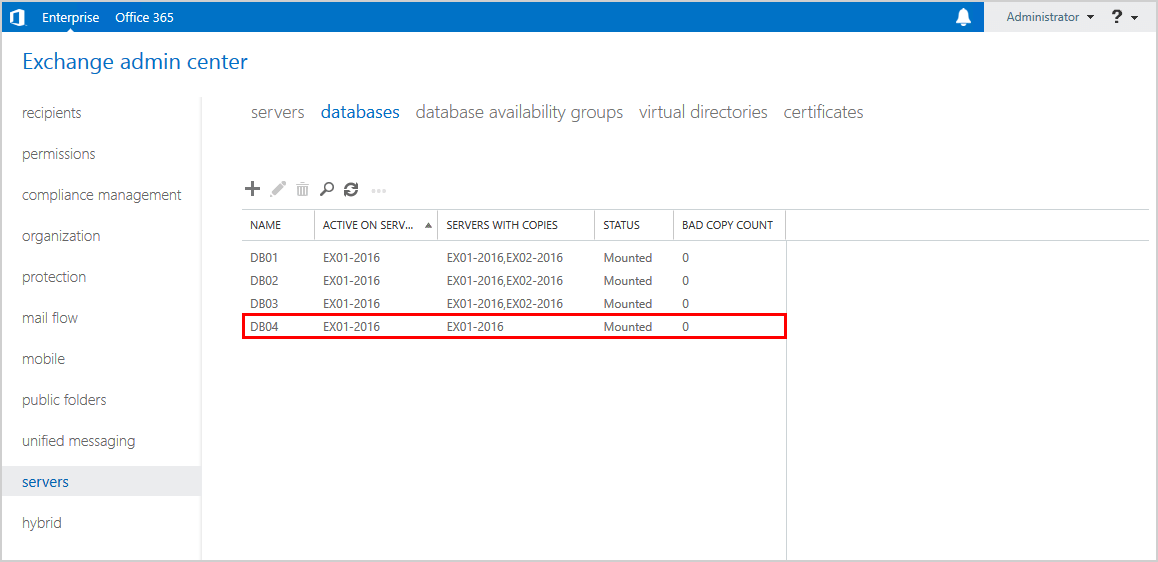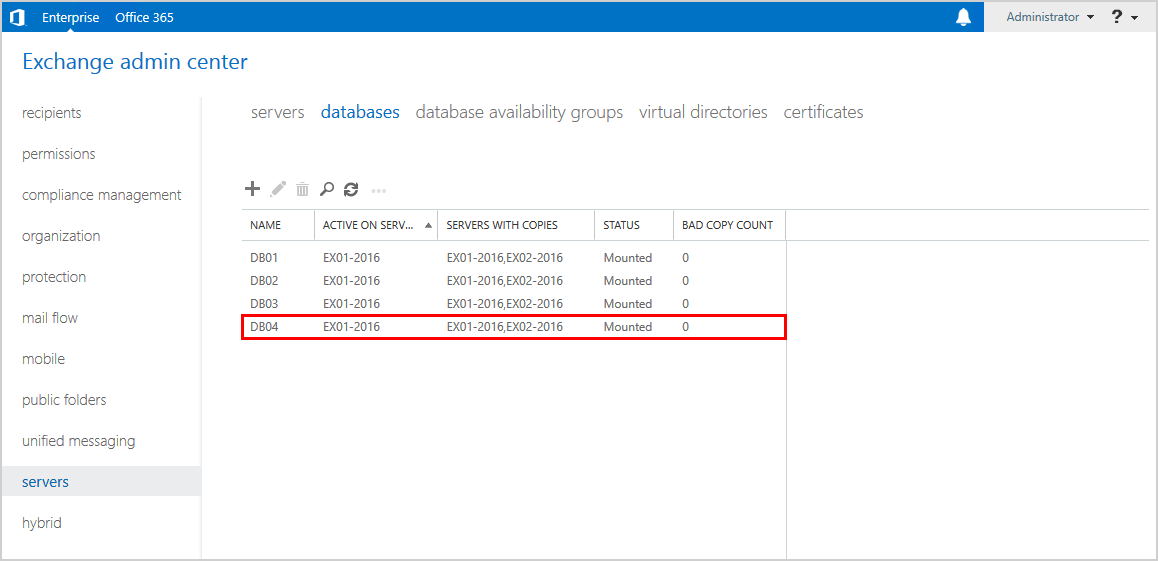Microsoft released several Security Updates (SUs) for Microsoft Exchange Server to address vulnerabilities that have…
Check Exchange database copy seed status
How to check Exchange database copy seed status after you add a mailbox database copy? You want to know the percentage and speed of the mailbox database copy seeding. With that information, you can update the team or have an estimated time the next time you need to add a database copy. In this article, we will be looking at the Exchange database copy seeding status.
Table of contents
Before you start
We already have four mailbox databases configured. Three of the databases have a database copy. The mailbox database DB04 does not have a mailbox database copy. We will add a mailbox database copy, and after that, we will check the Exchange database copy seed status.
We have the following configured in the Exchange Server:
Get mailbox database copy status
In Exchange Admin Center, you will see the Server with copies column is only Exchange Server EX01-2016.

Run Exchange Management Shell as administrator. Use Get-MailboxDatabaseCopyStatus cmdlet. Add the mailbox database identity. In this example, it’s mailbox database DB04.
You can see it’s only on Exchange Server EX01-2016.
[PS] C:\>Get-MailboxDatabaseCopyStatus "*DB04" | ft -AutoSize
Name Status CopyQueueLength ReplayQueueLength LastInspectedLogTime ContentIndexState
---- ------ --------------- ----------------- -------------------- -----------------
DB04\EX01-2016 Mounted 0 0 HealthyAfter adding a database copy to database DB04, let’s check the database copy seeding status.
Database copy seed status single mailbox database
We only want to check the mailbox database copy of DB04.
The database seed status shows in detail:
- Percentage
- Read
- Written
- ReadPerSec
- WrittenPerSec
[PS] C:\>Get-MailboxDatabaseCopyStatus "*DB04" | ft Name,Status,DatabaseSeedStatus
Name Status DatabaseSeedStatus
---- ------ ------------------
DB04\EX01-2016 Mounted
DB04\EX02-2016 Seeding Percentage:36; Read:1.891 GB; Written:1.891 GB; ReadPerSec:137.2 MB; WrittenPerSec:137.2 MBDatabase copy seed status of all mailbox databases
Do you want to check the database seeding status of multiple mailbox databases?
[PS] C:\>Get-MailboxDatabaseCopyStatus * | ft Name,Status,DatabaseSeedStatus
Name Status DatabaseSeedStatus
---- ------ ------------------
DB01\EX01-2016 Mounted
DB02\EX01-2016 Mounted
DB03\EX01-2016 Mounted
DB04\EX01-2016 Mounted
DB01\EX02-2016 Healthy
DB03\EX02-2016 Healthy
DB02\EX02-2016 Healthy
DB04\EX02-2016 Seeding Percentage:44; Read:2.287 GB; Written:2.287 GB; ReadPerSec:190.7 MB; WrittenPerSec:190.7 MBFilter only on the Status equal Seeding.
[PS] C:\>Get-MailboxDatabaseCopyStatus * | Where {$_.Status -eq "Seeding"} | ft Name,Status,DatabaseSeedStatus
Name Status DatabaseSeedStatus
---- ------ ------------------
DB04\EX02-2016 Seeding Percentage:50; Read:2.612 GB; Written:2.612 GB; ReadPerSec:196.3 MB; WrittenPerSec:196.3 MBVerify mailbox database copy status health
Now that it’s finished, the DatabaseSeedStatus column is empty. The Status column shows the mailbox database copy on Exchange Server EX02-2016 as healthy.
[PS] C:\>Get-MailboxDatabaseCopyStatus "*DB04" | ft Name,Status,DatabaseSeedStatus
Name Status DatabaseSeedStatus
---- ------ ------------------
DB04\EX01-2016 Mounted
DB04\EX02-2016 HealthyIn Exchange Admin Center, the servers with copies column are updated with both Exchange Servers.

Everything looks great. Did this help you to check the Exchange database seeding status details?
Read more: Activate database copy failed content index disabled »
Conclusion
You learned how to check Exchange database copy seed status. Start PowerShell and run the commands as shown, and you will get the percentage of the seed status in detail. The next time you add a database copy, you already have an estimate of how long the seeding will take.
Did you enjoy this article? You may also like Truncate Exchange logs with PowerShell. Don’t forget to follow us and share this article.



This Post Has 0 Comments